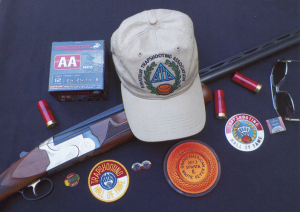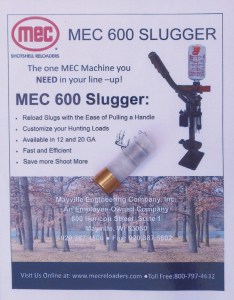by Larry S. Sterett | Contributing Editor
The 2013 World Trapshooting Championships were held at the Sparta, IL, World Shooting Complex Aug. 7-17 with nearly 10,000 competitors participating in the 24 scheduled events. The weather was close to perfect, unlike the 2012 Grand American with its storm that rolled garbage cans, turned over scorer’s stands, and demolished some of the vendor tents.
The weather this year was hot, but not hot enough to fry eggs on the sidewalk, and the possibility of lightning did shut the line down for about 90 minutes during one of the preliminary week events, when the Weather Service reported an approaching storm.

The Grand American is the premier event in the trapshooting world. The NRA was providing two boxes of specially marked Winchester AA shot shells with new or renewed membership; White Flyer was giving out a sample souvenir target, and some of the firms handed out souvenir pins.
The big news was the winner of the final event, the Grand American Handicap. Joseph Winburn, a 24-yearold from Winchester, KY, shooting a Ljutic shotgun, walked away with the trophy following a shoot-off. Winburn, a 20.5-yard shooter, had been shooting registered targets for just one year, had never shot at the Grand American previously, and had never broken more than 97 targets in a handicap event.
This time he broke 99 out of the 100 targets in Event No.
24, and then was perfect in the shoot off to claim the Grand American Handicap title.
When the announcement was made, and Winburn heard he had won, he remarked, “I was nervous. It’s great.
We came up here. I never thought I would go this far.” Winburn’s 99 in the premier event was not the only 99.
There were five other shooters with the same score: Russ Stiner of Iowa; John Gioffre and Richard Marshall, both of Ohio, William Tempest of Indiana, and Mitchell Loveless of Tennessee. In the shoot-off, Marshall, Loveless, and
Tempest shot on one field; Marshall and Loveless are 27-yard shooters, and Tempest shoots from the 26-yard line.
Gioffre and Stiner, both 23.5-yard shooters, were on another field, leaving Winburn, a 20.5-yard shooter alone on a third field.
Winburn considered his being alone a negative. “You never do it other than this [shoot together]. You have to stop and take your time. Usually you have to wait for everyone else to go through. You aren’t in a hurry. It makes you feel rushed [shooting alone], at least it does me.” Because he was shooting alone Winburn took this time, and was still shooting when Loveless, Marshall, and Tempest finished their shooting. “I was trying to stay calm,” he remarked.
“Nervous is what I was, and then you have them over there. You could hear them. I could hear them shooting. I couldn’t hear the score, what they were doing. I had no idea.” It was probably good Winburn didn’t hear the scores. Tempest had run his first 24 targets straight, but missed the last one. A shoot-off was possible.
Winburn powdered 24 targets, one not so great, but he had broken all 25 targets. “Most of them were pretty good breaks,” he stated. “There was one…I must have hooked it.” “It was probably better [that I didn’t know how the others were doing]” Winburn said. “I really don’t want to know what they’re doing to be honest with you.” Thus it is. The Grand American Handicap is always full of surprises. It has been won by experienced shooters, and it has been won by neophytes. It has been won by shooters using expensive shotguns, and by shooters using second- and third-hand previously- owned low-priced shotguns. The shotguns have been side/side, single barrel, over/under, pumps, and possibly even an auto-loader. About the only model of shotgun which has not been used to win the Grand American Handicap, at least to this shooter’s knowledge, is a bolt-action.

One of the most interesting items at the Grand, other than the shotguns, was the new MEC 600 Slugger, a single-stage press for loading rifled slugs. It features three dies which produce a turned over crimp similar to a roll crimp. It’s available in a choice of 20 or 12 gauge. (The shell shown was loaded on the 600 Slugger press being exhibited at the MEC booth at the Grand.)
On the evening of Aug. 13, the 45th Annual ATA Trapshooting Hall of Fame Induction Banquet was held in the WSRC Main Events Building. Most of the round tables seating eight persons were occupied. (This shooter sat at a table with three other Larry’s, one from California, one from Florida, me from Illinois, and one from New Jersey. The wife of the California Larry had some interesting stories, as she had been raised on The Rock (Alcatraz Island) where her father was a tower guard.
(Actually, the conversation was better than the food.) The three inductees were Dean Bright, Lawrence Russo Jr., and Calvin L. Stinson Jr.
Talk of the ATA Hall of Fame moving to Sparta has been heard since shortly after the Grand moved to Illinois. Now it is thought the Hall may be constructed and ready for the 2015 Grand, but probably not for the 2014 Grand. At least an artist’s concept of the new building was on display in the Events Center this year. According to Jim Bradford Jr., chairman of the Hall of Fame and Museum, “We have signed a contract with a local architectural firm.” The 8,700 square-foot building will be located west of the main entrance drive and Events Center and to the northeast of the Mall containing the shellhouse. Current plans call for the building to include a lobby, exhibit hall, administrative offices, restrooms, conference/theater room, storage area, and an exhibit preparation area. It should be better than the old museum complex in Vandalia. (Shooters and visitors wanting to view some of the firearms in the ATA Museum collection can do so if they happen to be in the vicinity of Springfield, MO, possibly on the way to Branson.
The first year the Grand American was held at Sparta a visitor might have formed the impression there were more police than there were shooters. There were uniformed police—Illinois State, Conservation, etc.—literally everywhere, in groups, or in pairs, in vehicles and on foot, on the roads, near the entrances, and on the grounds.
Today, there are still a few authority figures, usually DNR conservation officers around, but they are seldom seen; there was even at least one on a bicycle this year. When asked if being on a bike made her more approachable, Carla Settles, IDNR, stated “I think it does (make us more approachable) because we’re right here, face-to-face, as opposed to up in a truck. We’re not so scary…it’s a good PR tool. You’re out of the vehicle, you’re close to people.
The kids like to see it.” If you are not shooting at the Grand, or watching the shooting, eating, or taking a break, then you should be checking out the vendor malls, or the tent vendors on the east portion of the line. Representatives of the ammunition manufacturers—Federal, Remington, Winchester, etc.—were there along with assorted arms manufacturers, including Beretta, Browning, Krieghoff, Ljutic and Perazzi, and many independent gun dealers, such as Jaqua’s Fine Guns of Findlay, OH.
Among the new products observed at the Grand this year was Krieghoff’s (7528 Easton Rd., Dept. TGM, Ottsville, PA 18942; phone: 610-847- 5173; online: krieghoff.com) new 12- gauge KX-6 single barrel. Priced at just under $5,500, the KX-6 features a 34” barrel with ventilated, free-floating rib adjustable for point-of-impact, choice of three choke tubes, an ergonomic stock—right or left-hand—with comb adjustable for drop and cast, and a trigger adjustable for grip length and let-off. (The letoff is factory set at 3½ pounds.) Options include a release trigger, and length-ofpull buttstock spacers, or a fully adjustable butt plate.
Weight of the KX-6 is approximately 8¾ pounds, and it comes with a lightweight fitted carrying case.
Shooters are always looking for a way to improve their scores, and if reducing recoil will do it, this may be worth checking out. One of the more unusual devices used to achieve this reduction is the Stock Lock II shown at the 2013 Grand. Produced by Dawson Enterprises (7191 Nave SW, Dept. TGM, Massillon, OH 44646; phone: 330-833-0014; online: dawsonent.com) using CNC technology, the Stock Lock II is priced at just under two grand—the approximate price of two economy trap guns. Available, currently, for most Blaser, Caesar Guerini, Krieghoff and Perazzi model shotguns, it features Grade A American walnut construction with adjustable comb, length-of-pull, pitch, pad, right or left-hand, cast-off or cast-on, pitch, and grip size, and superior recoil reduction.
(Think of the type of recoil reduction Winchester had available a couple of decade or so back, where the stock moves and not the shooter.) Mayville Engineering Company (800 Horicon St., Ste 1, Dept. TGM, Mayville, WI 53050; phone: 800-427- 4MEC; online: mecreloaders.com) has offered reasonably priced reloading presses since the middle of the last century. The current line includes singlestage and progressive models capable of reloading any shell from the .410- bore to the 10-gauge, depending on the model. The latest model is the 600 Slugger to load rifled slugs, and it’s available for 12- or 20-gauge.
Single-stage, the Slugger uses three dies to form what resembles a deep rolled crimp.
The 2013 Grand is history, and as usual, or at least more often than not, the Grand American Handicap winner produced a surprise.



